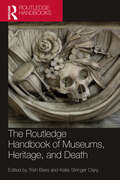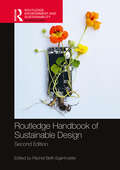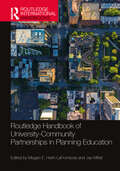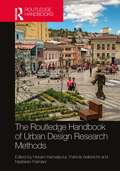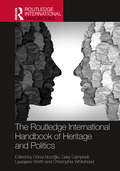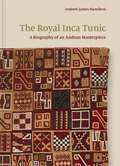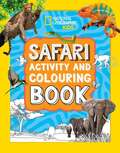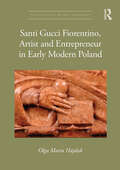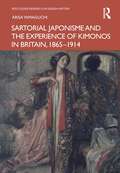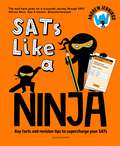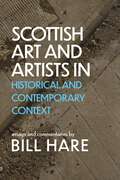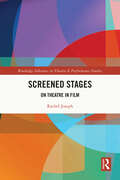- Table View
- List View
The Routledge Handbook of Museums, Heritage, and Death (Routledge Handbooks on Museums, Galleries and Heritage)
by Trish Biers Katie Stringer ClaryThis book provides a comprehensive examination of death, dying, and human remains in museums and heritage sites around the world. Presenting a diverse range of contributions from scholars, practitioners, and artists, the book reminds us that death and the dead body are omnipresent in museum and heritage spaces. Chapters appraise collection practices and their historical context, present global perspectives and potential resolutions, and suggest how death and dying should be presented to the public. Acknowledging that professionals in the galleries, libraries, archives, and museums (GLAM) fields are engaging in vital discussions about repatriation and anti-colonialist narratives, the book includes reflections on a variety of deathscapes that are at the forefront of the debate. Taking a multivocal approach, the handbook provides a foundation for debate as well as a reference for how the dead are treated within the public arena. Most important, perhaps, the book highlights best practices and calls for more ethical frameworks and strategies for collaboration, particularly with descendant communities. The Routledge Handbook of Museums, Heritage, and Death will be useful to all individuals working with, studying, and interested in curation and exhibition at museums and heritage sites around the world. It will be of particular interest to those working in the fields of heritage, museum studies, death studies, archaeology, anthropology, sociology, and history.
The Routledge Handbook of Museums, Heritage, and Death (Routledge Handbooks on Museums, Galleries and Heritage)
by Trish Biers Katie Stringer ClaryThis book provides a comprehensive examination of death, dying, and human remains in museums and heritage sites around the world. Presenting a diverse range of contributions from scholars, practitioners, and artists, the book reminds us that death and the dead body are omnipresent in museum and heritage spaces. Chapters appraise collection practices and their historical context, present global perspectives and potential resolutions, and suggest how death and dying should be presented to the public. Acknowledging that professionals in the galleries, libraries, archives, and museums (GLAM) fields are engaging in vital discussions about repatriation and anti-colonialist narratives, the book includes reflections on a variety of deathscapes that are at the forefront of the debate. Taking a multivocal approach, the handbook provides a foundation for debate as well as a reference for how the dead are treated within the public arena. Most important, perhaps, the book highlights best practices and calls for more ethical frameworks and strategies for collaboration, particularly with descendant communities. The Routledge Handbook of Museums, Heritage, and Death will be useful to all individuals working with, studying, and interested in curation and exhibition at museums and heritage sites around the world. It will be of particular interest to those working in the fields of heritage, museum studies, death studies, archaeology, anthropology, sociology, and history.
Routledge Handbook of Sustainable Design (Routledge Environment and Sustainability Handbooks)
by Rachel Beth EgenhoeferThe Routledge Handbook of Sustainable Design considers the design, not only of artifacts, but of structures, systems, and interactions in the context of sustaining our shared planet. This revised edition introduces new and updated chapters, as well as a new section on pedagogy for sustainable design. With authors from around the world, design is positioned in context with recent crises such as global pandemics, racial reckoning, political unrest, and natural disasters. Just as design is an interdisciplinary field, the climate crisis is deeply tangled in racial justice, gender justice, global health, economics, trade, and more. Divided into six sections, it presents a holistic approach to understanding the many facets of sustainable design: Part 1: Systems and Design Part 2: Complexities of Sustainable Design Part 3: Community Engaged Design for Local and Global Diversity Part 4: Design for Sustainable Behaviors Part 5: Design Futures Part 6: Pedagogy in Design for Sustainability Arguing that design needs to restore, regenerate, and rejuvenate our planet and people, this handbook will be invaluable to researchers, students, and practitioners across all subdisciplines of design, architecture, business, energy management, visual arts, and environmental studies, among others.
Routledge Handbook of Sustainable Design (Routledge Environment and Sustainability Handbooks)
by Rachel Beth EgenhoeferThe Routledge Handbook of Sustainable Design considers the design, not only of artifacts, but of structures, systems, and interactions in the context of sustaining our shared planet. This revised edition introduces new and updated chapters, as well as a new section on pedagogy for sustainable design. With authors from around the world, design is positioned in context with recent crises such as global pandemics, racial reckoning, political unrest, and natural disasters. Just as design is an interdisciplinary field, the climate crisis is deeply tangled in racial justice, gender justice, global health, economics, trade, and more. Divided into six sections, it presents a holistic approach to understanding the many facets of sustainable design: Part 1: Systems and Design Part 2: Complexities of Sustainable Design Part 3: Community Engaged Design for Local and Global Diversity Part 4: Design for Sustainable Behaviors Part 5: Design Futures Part 6: Pedagogy in Design for Sustainability Arguing that design needs to restore, regenerate, and rejuvenate our planet and people, this handbook will be invaluable to researchers, students, and practitioners across all subdisciplines of design, architecture, business, energy management, visual arts, and environmental studies, among others.
Routledge Handbook of University-Community Partnerships in Planning Education (Routledge International Handbooks)
by Heim LaFrombois, Megan E. Jay MittalThis handbook explores two guiding questions – how can university-community partnerships in planning education work, and how can they be transformative? University-community partnerships – often referred to as service-learning or community-engaged teaching and learning – are traditionally based on a collaborative relationship between an academic partner and a community-based partner, in which students from the academic partner work within the community on a project. Transformational approaches to university-community partnerships are approaches that develop and sustain mutually beneficial collaborations where knowledge is co-created and new ways of knowing and doing are discovered. This edited volume examines a variety of university-community partnerships in planning education, from a number of different perspectives, with a focus on transformative models. The authors explore broader theoretical issues, including topics relating to pedagogy, planning theory, and curriculum; along with more practical topics relating to best practices, logistics, institutional support, outcome measures, and the various forms these partnerships can take – all through an array of case studies. The authors, which include academics, professional practitioners, academic practitioners, and students, bring an incredible depth and breadth of knowledge and experience from across the globe – Australia, Canada, Chile, Europe (including Germany, Spain, Slovakia, and Sweden), India, Jamaica, South Korea, and the United States.
Routledge Handbook of University-Community Partnerships in Planning Education (Routledge International Handbooks)
by Megan E. Heim LaFrombois Jay MittalThis handbook explores two guiding questions – how can university-community partnerships in planning education work, and how can they be transformative? University-community partnerships – often referred to as service-learning or community-engaged teaching and learning – are traditionally based on a collaborative relationship between an academic partner and a community-based partner, in which students from the academic partner work within the community on a project. Transformational approaches to university-community partnerships are approaches that develop and sustain mutually beneficial collaborations where knowledge is co-created and new ways of knowing and doing are discovered. This edited volume examines a variety of university-community partnerships in planning education, from a number of different perspectives, with a focus on transformative models. The authors explore broader theoretical issues, including topics relating to pedagogy, planning theory, and curriculum; along with more practical topics relating to best practices, logistics, institutional support, outcome measures, and the various forms these partnerships can take – all through an array of case studies. The authors, which include academics, professional practitioners, academic practitioners, and students, bring an incredible depth and breadth of knowledge and experience from across the globe – Australia, Canada, Chile, Europe (including Germany, Spain, Slovakia, and Sweden), India, Jamaica, South Korea, and the United States.
The Routledge Handbook of Urban Design Research Methods
by Hesam Kamalipour Patricia Aelbrecht Nastaran PeimaniAs an evolving and contested field, urban design has been made, unmade, and remade at the intersections of multiple disciplines and professions. It is now a decisive moment for urban design to reflect on its rigour and relevance. This handbook is an attempt to seize this moment for urban design to further develop its theoretical and methodological knowledge base and engage with the question of "what urban design can be" with a primary focus on its research. This handbook includes contributions from both established and emerging scholars across the global North and global South to provide a more field-specific entry point by introducing a range of topics and lines of inquiry and discussing how they can be explored with a focus on the related research designs and methods. The specific aim, scope, and structure of this handbook are appealing to a range of audiences interested and/or involved in shaping places and public spaces. What makes this book quite distinctive from conventional handbooks on research methods is the way it has been structured in relation to some key research topics and questions in the field of urban design regarding the issues of agency, affordance, place, informality, and performance. In addition to the introduction chapter, this handbook includes 80 contributors and 52 chapters organised into five parts. The commissioned chapters showcase a wide range of topics, research designs, and methods with references to relevant scholarly works on the related topics and methods.
The Routledge Handbook of Urban Design Research Methods
by Hesam Kamalipour Patricia Aelbrecht Nastaran PeimaniAs an evolving and contested field, urban design has been made, unmade, and remade at the intersections of multiple disciplines and professions. It is now a decisive moment for urban design to reflect on its rigour and relevance. This handbook is an attempt to seize this moment for urban design to further develop its theoretical and methodological knowledge base and engage with the question of "what urban design can be" with a primary focus on its research. This handbook includes contributions from both established and emerging scholars across the global North and global South to provide a more field-specific entry point by introducing a range of topics and lines of inquiry and discussing how they can be explored with a focus on the related research designs and methods. The specific aim, scope, and structure of this handbook are appealing to a range of audiences interested and/or involved in shaping places and public spaces. What makes this book quite distinctive from conventional handbooks on research methods is the way it has been structured in relation to some key research topics and questions in the field of urban design regarding the issues of agency, affordance, place, informality, and performance. In addition to the introduction chapter, this handbook includes 80 contributors and 52 chapters organised into five parts. The commissioned chapters showcase a wide range of topics, research designs, and methods with references to relevant scholarly works on the related topics and methods.
Routledge Handbook on Arab Cinema
Building on a growing body of literature, this Handbook provides an up-to-date and authoritative survey of Arab cinema.The collection includes contributions from academics and filmmakers from across the Arab region, Europe, and North America, and fills a gap in media studies by examining the entire Arab region, rather than focusing on one country or theme. The Handbook also sheds light on the heterogeneity of Arab filmmaking not only within the Arab region, but also globally, within diasporic communities. It is split into six parts: Part 1 provides an overview of each sub-region in the Arab world, including a chapter on Arab animation films. Parts 2, 3, and 4 address topical themes, encompassing the representation of gender, religion, and identity politics in Arab cinema. Part 5 discusses the theme of diaspora and Part 6 concludes the volume with reflective essays penned by selected diasporic filmmakers. This book is an essential reference for Arab media and cinema scholars, students, and professional filmmakers. With case studies from across the Arab region, it's also a valuable resource for anyone interested in film and media, global cinema, and the Middle East generally.
Routledge Handbook on Arab Cinema
by Noha MellorBuilding on a growing body of literature, this Handbook provides an up-to-date and authoritative survey of Arab cinema.The collection includes contributions from academics and filmmakers from across the Arab region, Europe, and North America, and fills a gap in media studies by examining the entire Arab region, rather than focusing on one country or theme. The Handbook also sheds light on the heterogeneity of Arab filmmaking not only within the Arab region, but also globally, within diasporic communities. It is split into six parts: Part 1 provides an overview of each sub-region in the Arab world, including a chapter on Arab animation films. Parts 2, 3, and 4 address topical themes, encompassing the representation of gender, religion, and identity politics in Arab cinema. Part 5 discusses the theme of diaspora and Part 6 concludes the volume with reflective essays penned by selected diasporic filmmakers. This book is an essential reference for Arab media and cinema scholars, students, and professional filmmakers. With case studies from across the Arab region, it's also a valuable resource for anyone interested in film and media, global cinema, and the Middle East generally.
The Routledge Handbook on Greening High-Density Cities: Climate, Society and Health (Routledge International Handbooks)
by Kheir Al-Kodmany Peng Du Mir M. AliThis new handbook provides a platform to bring together multidisciplinary researchers focusing on greening high-density agglomerations from three perspectives: climate change, social implications, and people’s health. Written by leading scholars and experts, the chapters aim to summarize the “state-of-the-art” and produce a reference book for policymakers, practitioners, academics, and researchers to study, design, and build high-density cities by integrating green spaces. The topics covered in the book include (but are not limited to) Urban Heat Island, Green Space and Carbon Sequestration, Green Space and Social Equity, Green Space and Public Health, Biophilic Cities, Urban Agriculture, Vertical Farms, Urban Farming Technologies, Nature and Biodiversity, Nature and Health, Biophilic Design, Green Infrastructure, Urban Revitalization, Post-Covid Cities, Smart and Resilient Cities, Tall Buildings, and Sustainable Vertical Cities.
The Routledge Handbook on Greening High-Density Cities: Climate, Society and Health (Routledge International Handbooks)
This new handbook provides a platform to bring together multidisciplinary researchers focusing on greening high-density agglomerations from three perspectives: climate change, social implications, and people’s health. Written by leading scholars and experts, the chapters aim to summarize the “state-of-the-art” and produce a reference book for policymakers, practitioners, academics, and researchers to study, design, and build high-density cities by integrating green spaces. The topics covered in the book include (but are not limited to) Urban Heat Island, Green Space and Carbon Sequestration, Green Space and Social Equity, Green Space and Public Health, Biophilic Cities, Urban Agriculture, Vertical Farms, Urban Farming Technologies, Nature and Biodiversity, Nature and Health, Biophilic Design, Green Infrastructure, Urban Revitalization, Post-Covid Cities, Smart and Resilient Cities, Tall Buildings, and Sustainable Vertical Cities.
The Routledge International Handbook of Heritage and Politics (Routledge Handbooks on Museums, Galleries and Heritage)
The Routledge International Handbook of Heritage and Politics surveys the intersection of heritage and politics today and helps elucidate the political implications of heritage practices. It explicitly addresses the political and analyses tensions and struggles over the distribution of power. Including contributions from early-career scholars and more established researchers, the Handbook provides global and interdisciplinary perspectives on the political nature, significance and consequence of heritage and the various practices of management and interpretation. Taking a broad view of heritage, which includes not just tangible and intangible phenomena, but the ways in which people and societies live with, embody, experience, value and use the past, the volume provides a critical survey of political tensions over heritage in diverse social and cultural contexts. Chapters within the book consider topics such as: neoliberal dynamics; terror and mobilisations of fear and hatred; old and new nationalisms; public policy; recognition; denials; migration and refugeeism; crises; colonial and decolonial practice; communities; self- and personhood; as well as international relations, geopolitics, soft power and cooperation to address global problems.The Routledge International Handbook of Heritage and Politics makes an intervention into the theoretical debate about the nature and role of heritage as a political resource. It is essential reading for academics and students working in heritage studies, museum studies, politics, memory studies, public history, geography, urban studies and tourism.
The Routledge International Handbook of Heritage and Politics (Routledge Handbooks on Museums, Galleries and Heritage)
by Gönül Bozoğlu Gary Campbell Laurajane Smith Christopher WhiteheadThe Routledge International Handbook of Heritage and Politics surveys the intersection of heritage and politics today and helps elucidate the political implications of heritage practices. It explicitly addresses the political and analyses tensions and struggles over the distribution of power. Including contributions from early-career scholars and more established researchers, the Handbook provides global and interdisciplinary perspectives on the political nature, significance and consequence of heritage and the various practices of management and interpretation. Taking a broad view of heritage, which includes not just tangible and intangible phenomena, but the ways in which people and societies live with, embody, experience, value and use the past, the volume provides a critical survey of political tensions over heritage in diverse social and cultural contexts. Chapters within the book consider topics such as: neoliberal dynamics; terror and mobilisations of fear and hatred; old and new nationalisms; public policy; recognition; denials; migration and refugeeism; crises; colonial and decolonial practice; communities; self- and personhood; as well as international relations, geopolitics, soft power and cooperation to address global problems.The Routledge International Handbook of Heritage and Politics makes an intervention into the theoretical debate about the nature and role of heritage as a political resource. It is essential reading for academics and students working in heritage studies, museum studies, politics, memory studies, public history, geography, urban studies and tourism.
The Royal Inca Tunic: A Biography of an Andean Masterpiece
by Andrew James HamiltonThe hidden life of the greatest surviving work of Inca artThe most celebrated Andean artwork in the world is a five-hundred-year-old Inca tunic made famous through theories about the meanings of its intricate designs, including attempts to read them as a long-lost writing system. But very little is really known about it. The Royal Inca Tunic reconstructs the history of this enigmatic object, presenting significant new findings about its manufacture and symbolism in Inca visual culture.Andrew James Hamilton draws on meticulous physical examinations of the garment conducted over a decade, wide-ranging studies of colonial Peruvian manuscripts, and groundbreaking research into the tunic&’s provenance. He methodically builds a case for the textile having been woven by two women who belonged to the very highest echelon of Inca artists for the last emperor of the Inca Empire on the eve of the Spanish invasion in 1532. Hamilton reveals for the first time that this imperial vestment remains unfinished and has suffered massive dye fading that transforms its appearance today, and he proposes a bold new conception of what this radiant masterpiece originally looked like.Featuring stunning photography of the tunic and Hamilton&’s own beautiful illustrations, The Royal Inca Tunic demonstrates why this object holds an important place in the canon of art history as a deft creation by Indigenous women artists, a reminder of the horrors of colonialism, and an emblem of contemporary Andean identity.
The Royal Inca Tunic: A Biography of an Andean Masterpiece
by Andrew James HamiltonThe hidden life of the greatest surviving work of Inca artThe most celebrated Andean artwork in the world is a five-hundred-year-old Inca tunic made famous through theories about the meanings of its intricate designs, including attempts to read them as a long-lost writing system. But very little is really known about it. The Royal Inca Tunic reconstructs the history of this enigmatic object, presenting significant new findings about its manufacture and symbolism in Inca visual culture.Andrew James Hamilton draws on meticulous physical examinations of the garment conducted over a decade, wide-ranging studies of colonial Peruvian manuscripts, and groundbreaking research into the tunic&’s provenance. He methodically builds a case for the textile having been woven by two women who belonged to the very highest echelon of Inca artists for the last emperor of the Inca Empire on the eve of the Spanish invasion in 1532. Hamilton reveals for the first time that this imperial vestment remains unfinished and has suffered massive dye fading that transforms its appearance today, and he proposes a bold new conception of what this radiant masterpiece originally looked like.Featuring stunning photography of the tunic and Hamilton&’s own beautiful illustrations, The Royal Inca Tunic demonstrates why this object holds an important place in the canon of art history as a deft creation by Indigenous women artists, a reminder of the horrors of colonialism, and an emblem of contemporary Andean identity.
Santi Gucci Fiorentino, Artist and Entrepreneur in Early Modern Poland (ISSN)
by Olga Maria HajdukThe original research in this book analyzes the artistic activity of Santi Gucci (1533– c.1600), a Florentine sculptor active in Poland in the second half of the sixteenth century, and his workshop.Chapters examine the organization of the artistic workshop (sculpting and masonry) and the model of the artist’s functioning as an entrepreneur in Renaissance Poland, using Santi Gucci’s activity as an example. Gucci shaped the image of Polish sculpture in the sixteenth century for more than 50 years, even though his work has not yet been fully examined. The author sets Gucci’s emigration within the context of the cultural exchanges between Italy and Poland that contributed to the development of the Polish Renaissance.The book will be of interest to scholars working in art history, Renaissance studies, architectural history and economic history.
Santi Gucci Fiorentino, Artist and Entrepreneur in Early Modern Poland (ISSN)
by Olga Maria HajdukThe original research in this book analyzes the artistic activity of Santi Gucci (1533– c.1600), a Florentine sculptor active in Poland in the second half of the sixteenth century, and his workshop.Chapters examine the organization of the artistic workshop (sculpting and masonry) and the model of the artist’s functioning as an entrepreneur in Renaissance Poland, using Santi Gucci’s activity as an example. Gucci shaped the image of Polish sculpture in the sixteenth century for more than 50 years, even though his work has not yet been fully examined. The author sets Gucci’s emigration within the context of the cultural exchanges between Italy and Poland that contributed to the development of the Polish Renaissance.The book will be of interest to scholars working in art history, Renaissance studies, architectural history and economic history.
Sartorial Japonisme and the Experience of Kimonos in Britain, 1865-1914 (Routledge Research in Design History)
by Arisa YamaguchiUsing interdisciplinary research and critical analysis, this book examines experiences through (or with) kimonos in Britain during the late Victorian and Edwardian periods. Bringing new perspectives to challenge the existing model of ‘Japonisme in fashion’ and introducing overlooked contacts between kimonos and people, this book explores not only fine arts and department stores but also a variety of theatres and cheap postcards. Putting a particular focus on the responses and reactions elicited by kimonos in visual, textual and material forms, this book initiates an entirely new discussion on the British adoption of Japanese kimonos beyond the monolithic view of the relationship between the East and West. This book will be of interest to scholars working in fashion studies, British studies, Japanese studies, design history and art history.
Sartorial Japonisme and the Experience of Kimonos in Britain, 1865-1914 (Routledge Research in Design History)
by Arisa YamaguchiUsing interdisciplinary research and critical analysis, this book examines experiences through (or with) kimonos in Britain during the late Victorian and Edwardian periods. Bringing new perspectives to challenge the existing model of ‘Japonisme in fashion’ and introducing overlooked contacts between kimonos and people, this book explores not only fine arts and department stores but also a variety of theatres and cheap postcards. Putting a particular focus on the responses and reactions elicited by kimonos in visual, textual and material forms, this book initiates an entirely new discussion on the British adoption of Japanese kimonos beyond the monolithic view of the relationship between the East and West. This book will be of interest to scholars working in fashion studies, British studies, Japanese studies, design history and art history.
SATs Like a Ninja: Key facts and revision tips to supercharge your SATs
by Andrew JenningsPRAISE FOR BOOKS IN THE LIKE A NINJA SERIES'Super engaging and accessible' PIERS TORDAY'An imaginative and affordable resource' CLASS READS'Jam-packed with top-class tips you won't want to miss' MC GrammarFrom Andrew Jennings, the bestselling author @VocabularyNinja, SATs Like a Ninja is the must-have pocketbook packed with practical advice on how to boost your revision practice and tackle KS2 SATs like a pro.When SATs loom, panic can set in. Have you practised enough prefixes? Can you remember how to calculate a percentage? What was the difference between a colon and a semi-colon, again? There's so much to remember, so many different techniques and tips to grasp – it can be overwhelming for parents, never mind the children! With SATs Like a Ninja, you have everything you need at your fingertips to supercharge your SATs practice. This comprehensive mini guide to Key Stage 2 SATs contains everything a pupil needs to meet the demands of the KS2 National Curriculum assessments. The book is divided into three sections with advice, key concepts and fail-safe strategies throughout. The maths section covers key maths facts, arithmetic and tips to tackle reasoning and word problems. The reading section offers reading strategies, advice, as well as mini texts and associated worked example questions. Finally, the spelling, punctuation and grammar (SPaG) section tackles the trickiest spelling rules, explains those fiddly fronted adverbials and, amongst other things, explores the difference between there, they're and their.For more must-have Ninja books by Andrew Jennings (@VocabularyNinja), check out Vocabulary Ninja, Maths Like a Ninja, Write Like a Ninja, Spell Like a Ninja, SATs Like a Ninja and Comprehension Ninja.
Scottish Art and Artists in Historical and Contemporary Context (Scottish Art & Artists)
by Bill HareIn comparison with many who write about contemporary art, Hare is never self indulgent or wilfully obscure – there is no bogus theorising to be found here. From the Foreword by ALEXANDER MOFFAT Alan Davie • Eduardo Paolozzi • William Turnbull • Janet Boulton • Ian Hamilton Finlay • Joan Eardley • Anthony Hatwell • Colquhoun and MacBryde • Boyle Family • Jack Knox • Barbara Rae • Lys Hansen • Joyce Cairns • Doug Cocker • John Kirkwood • Steven Campbell • Ken Currie • Peter Howson • Henry Kondracki • Paul Reid • Iain Robertson • Douglas Gordon This book is a wide-ranging exploration of Scottish art and artists by one of Scotland's leading art historians. Navigating the intricacies of aesthetic debate with attitude and aplomb, Bill Hare examines the historical forces that have shaped Scottish art. His elegant, approachable writings are a treasure-house of informed discourse. Illuminating and perennially relevant, these essays offer stimulating perspectives and nuanced insights into the confluence of passion, mystery and myth that lies at the heart of the best of Scottish art.
Screened Stages: On Theatre in Film (ISSN)
by Rachel JosephThis book is devoted to tracing the variety of ways that theatre, theatricality, and performance are embedded in Hollywood cinema as screened stages.A screened stage is the literal or metaphorical appearance of a stage on screen. When the Hollywood style emerged in cinema history it traumatically severed the entwined relationship between film and theatre. The book makes the argument that cinema longs for theatre after that separation. The histories of stage and screen persistently crisscross one another making their separation problematic. The screened stage from the end of the nineteenth century until now offers a miniaturized version of cinema and theatre history. Moments of the stage within the screen compress historical styles and movements into saturated representations on film. Such examples overflow the cinematic screen into singular manifestations of presentness. Screened stages uncover what it means to be simultaneously present and absent.This book would be of great interest to students and scholars of theatre, film, dance, and performance.
Screened Stages: On Theatre in Film (ISSN)
by Rachel JosephThis book is devoted to tracing the variety of ways that theatre, theatricality, and performance are embedded in Hollywood cinema as screened stages.A screened stage is the literal or metaphorical appearance of a stage on screen. When the Hollywood style emerged in cinema history it traumatically severed the entwined relationship between film and theatre. The book makes the argument that cinema longs for theatre after that separation. The histories of stage and screen persistently crisscross one another making their separation problematic. The screened stage from the end of the nineteenth century until now offers a miniaturized version of cinema and theatre history. Moments of the stage within the screen compress historical styles and movements into saturated representations on film. Such examples overflow the cinematic screen into singular manifestations of presentness. Screened stages uncover what it means to be simultaneously present and absent.This book would be of great interest to students and scholars of theatre, film, dance, and performance.
